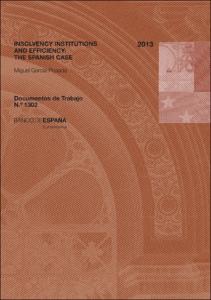Insolvency institutions and efficiency : the Spanish case
Autor
Fecha de publicación
8-feb-2013
Descripción física
51 p. : fórmulas, gráf., tab.
Resumen
El presente trabajo alerta sobre las potenciales pérdidas de eficiencia asociadas a bajas tasas de concursos empresariales (número de empresas que solicitan concurso de acreedores dividido por el total de empresas) y muestra que el bienestar podría mejorar al incrementar la protección de los acreedores en el concurso. Estas ideas son ilustradas con el caso español. También se predice una correlación positiva entre bienestar y tasas de concursos, un resultado que parece coherente con la evidencia empírica. El argumento, analizado con un modelo de contratos incompletos que parte del de Bolton y Scharfstein (1996), es el siguiente. La baja eficiencia y la baja protección a los acreedores en el sistema concursal español en comparación con los de una institución de insolvencia alternativa, el sistema hipotecario, provocan que las empresas y sus acreedores generalmente canalicen el crédito y resuelvan sus problemas de insolvencia mediante esta segunda. Sin embargo, para poder usar el sistema hipotecario, algunas empresas deben sobreinvertir en capital (inmuebles, bienes de equipo), puesto que estos son los activos que pueden ser usados como garantía hipotecaria. Dicha sobreinversión lleva a ineficiencias productivas, las cuales pueden ser muy costosas para industrias que requieren un alto nivel de otros factores de producción (p. ej., I+D). Además, el sistema hipotecario es muy proacreedor, en el sentido de que siempre concede el control de los activos de la empresa a los acreedores en caso de impago. Dado que los acreedores están inherentemente sesgados a la liquidación, esto lleva a algunas liquidaciones ineficientes
The paper warns about the potential efficiency losses associated with low business bankruptcy rates (number of fi rms filing for bankruptcy as a proportion of the total stock of firms) and shows that welfare could be improved by increasing the protection of creditors in the bankruptcy system. These ideas are illustrated with the Spanish case. The paper also predicts a positive correlation between welfare and bankruptcy rates, a finding that seems consistent with the empirical evidence. The argument, analysed with an incomplete contracts model à la Bolton and Scharfstein (1996), is as follows. The low efficiency and low creditor protection of the Spanish bankruptcy system relative to those of an alternative insolvency institution, namely the mortgage system, mean that firms and their creditors mainly deal with credit provision and eventual insolvency through the latter. However, in order to use the mortgage system, some firms must overinvest in capital assets (real estate, equipment) since those are the assets that can be pledged as mortgage collateral. This overinvestment leads to productive ineffi ciencies, which may be very costly for industries that require a high level of other factors of production (e.g. R&D). Furthermore, the mortgage system is too creditor friendly, in the sense that it always grants the control of the firm’s assets to creditors in the event of default. Since creditors are inherently biased towards liquidation, this leads to some inefficient liquidations
The paper warns about the potential efficiency losses associated with low business bankruptcy rates (number of fi rms filing for bankruptcy as a proportion of the total stock of firms) and shows that welfare could be improved by increasing the protection of creditors in the bankruptcy system. These ideas are illustrated with the Spanish case. The paper also predicts a positive correlation between welfare and bankruptcy rates, a finding that seems consistent with the empirical evidence. The argument, analysed with an incomplete contracts model à la Bolton and Scharfstein (1996), is as follows. The low efficiency and low creditor protection of the Spanish bankruptcy system relative to those of an alternative insolvency institution, namely the mortgage system, mean that firms and their creditors mainly deal with credit provision and eventual insolvency through the latter. However, in order to use the mortgage system, some firms must overinvest in capital assets (real estate, equipment) since those are the assets that can be pledged as mortgage collateral. This overinvestment leads to productive ineffi ciencies, which may be very costly for industries that require a high level of other factors of production (e.g. R&D). Furthermore, the mortgage system is too creditor friendly, in the sense that it always grants the control of the firm’s assets to creditors in the event of default. Since creditors are inherently biased towards liquidation, this leads to some inefficient liquidations
Publicado en
Documentos de Trabajo / Banco de España, 1302
Materias
Bankruptcy; Mortgage; Insolvency; Efficiency; Concursos de acreedores; Hipotecas; Insolvencia; Eficiencia; Crisis empresariales; Crédito y mercado hipotecario; Derecho mercantil; España
Aparece en las colecciones:












